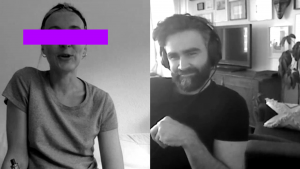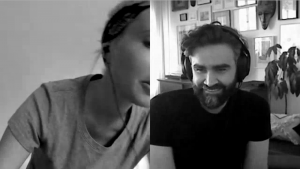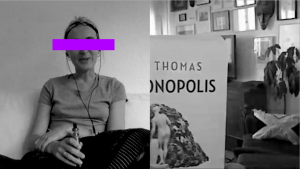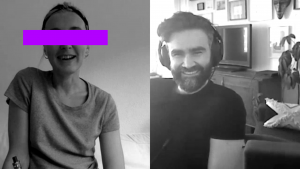Cameron Foden is Senior Denim Designer at Calvin Klein. We spoke on the developments of his job and noticable impacts on the fashion industry so far, under the circumstances of COVID-19.
22nd MARCH, 2020
(Ruth, pictured left) So, fashion…
(Cameron, pictured right) So, fashion. Obviously this is going to be very, very interesting. How all aspects; so a) consumerism as a whole, and b) fashion itself, will be effected. The luxury goods industry is going to be devastated, especially as people re-evaluate their priorities and their spending. With so much uncertainty people are going to have a complete change in their spending habits. I don’t think we can even begin to comprehend yet what it’s going to look like. Some people are saying we are looking at half a year (for recovery), other people are saying we are looking at up to two. Let’s see where we end up be next week, or next month. I suspect prospects are only going to look more and more grim.
For the fashion industry itself, we do know that we are seeing the first steps of essentially a recession; and many designers and others in the industry are going to lose their jobs. We are quite lucky for the time being in Europe with regards to worker’s rights, but it is really only a thin veneer of protection. Personally I know several designers in New York who have already been let go. That’s the reality of it – in an industry like fashion, which is not like something like law or medicine where you’re mostly only competing against others from your own country – you’re competing basically against designers and graduates from everywhere. Because everybody is willing to travel; to leave their friends and family for these “hallowed” positions. If you’re an older designer, the company could just decide one day you’re too expensive and replace you with a graduate who is willing to grind to 1am every day and be still there at 8am. I know because that used to be me.
These companies need to do everything they can to stay afloat, and going forward through all this craziness and uncertainty, we’re going to see a lot of changes that will effect a lot of people on the lower rungs of these ladders.
Have you had any layoffs at Calvin Klein yet that you know of?
Nothing that’s been communicated to me. However, I wouldn’t be surprised if they begin to happen. I don’t think it will happen now, maybe in 3-4 weeks – just going off gut feeling. March is already done. I have the feeling end of April is when we will begin to see real cuts. Once people get used to working at home, and it begins to be understood which aspects of the business, and which positions, are more agile with this new way of working. They’ll just start to see where the deadweight lies.
Are you taking any measures to secure yourself?
I’m just continuing to perform all my duties as best I can – to achieve and pre-empt all the work I would normally do in my normal day-to-day work. The only difference is that I’m now doing it at home. The problem is I’m a denim designer, and denim is very hands-on, it’s a very tactile design. And not having the denim washes here in hand, and not having the samples, is very difficult. However, we took the pre-emptive step to digitalise as much as we could beforehand, so for most of the tools need I am covered in basic terms. We will be fine to a certain extent – for a certain period of time.
For developing new washes and new fabrics – that’s a bit tricky because you need to be able to see and feel that. We will see how we will work around that. But I’m positive we will work it out. Compared to non-denim designers I’m in quite a fortunate position as we have far fewer new fits each season. We know we can fall back on best-sellers and we know how these look, mentally, so I’m fairly confident I will be able to continue working like this without too much hinderance for some time.
Where in the calendar are you now?
We are at design stage for Pre-Fall ’21.
Does this situation change your approach now to ‘newness’?
We’ll see. This is all going to be decided. I can already say there will more than likely be changes and cuts to the line. There will more than likely be some shifting. They will more than likely bring in some NOS styles (Never-Out-of-Stock). It’s all up in the air with showrooms and how things will be sold. I’m assuming they’re going to really push more of the digital aspect of it.
Earlier when you were speaking about seeing the future play out, you spoke of it “A. within consumerism, and B. within fashion”. Do you see these as separate?
I was more magnifying on the fashion industry aspect of it. If we look at consumerism, the only other times we have to go off, in terms of points in history are; the Great Depression, the 1973 oil crisis, and the financial crisis of 2008. Just looking at 2008, which is something that we know, and as ‘millennials’, and how hit we have been from that – where being unable to buy a house has become one of the biggest memes of our generation – basically, how Boomers ruined everything *laughs*. Just thinking back to fashion at that time, if we first remember pre- the crash, you had a lot of rise mass-spending; Primark, high-street etc. Mass-consumerism was rampant. Seeing videos of women in Topshop with arms laden in these piles and piles of clothes, just buying grotesque amounts of crap. It was this excessive idea of consumption – object gluttony.
Then 2008 came around and everybody was incredibly hard hit, and it took quite a while before you saw the trickle down. What came out of it, especially for menswear, was that you saw the rise of the “heritage trend”. This wasn’t just in fashion, it was in all products. This; “craftsmen”, “artisanal” – objects that got better as they got older. Which is why you saw leather jackets and leather boots, and denim. Jeans. Things like selvedge. And then you had: artisanal knives, artisanal jams, artisanal soaps … fucking artisanal everything. It was everywhere. And then it became cliched and horrendous because it went everywhere and lost its meaning as it was copied by everybody. And as everything in this new artisanal world was copied and made cheaper and mass-produced it was no longer desirable because luxury isn’t luxury if everything is luxury. No longer was it this idea of inherent luxury – of craftmanship and scarcity. It was just more stuff.
Also what happened in 2008 was you had these little pockets of ‘affordable luxury’. Around that time you saw COS emerge. You had this clean, “Scandinavian” aesthetic. It was suddenly possible for a lot of people, middle class men and women, to dress in quite a fashionable aesthetic at the time without breaking-bank. It was minimalist, that word. Had a very neutral colour palette with easy silhouettes. There was always this play between ‘close to body’ and ‘away from body’. It was a very aesthetically aware look. And that steamrolled a bit. Think the wide-legged crème trouser for women, a very Céline look.
So you had middle-class people with some disposable income, who couldn’t afford high ‘fashion’ but wanted the aesthetic of it, and suddenly they could achieve this through the high-street. And that grew. The iterations we have of that now are things like Arket, also from H&M. I suspect we’ll see a similar thing happen after this corona period, but the aesthetic will be different, or the mode of sales.
But since 2008-2009 fashion went through a strange period. With regards to the rise of Vetements, Balenciaga, Off-White etc. We saw that fashion, in a very expected turn… when fashion gets too “luxury”, it seeks perceived-trashiness. But never in the same way.
If we go back to fashion in the 1980’s, in the economic excess of the 80’s, you had the fashion elites pushing forward this idea of luxury – that is the strict system of couture. And then you these designers, at that time the Japanese designers (Rei Kawakubo, Yohji Yamamoto, Issey Miyake, Junya) and the Belgians (the Antwerp Six and Margiela), who came along a little bit later. The early 90’s. But the Japanese, they really explored deconstructivism. They sent raw seams down their runways in Paris and this caused quite a few elites to be genuinely upset. It’s amusing to look up and read some of the reactions. But the problem with this is that when you have a fashion idea that is “revolutionary”, it gets boiled down to its aesthetic. Because fashion is tied to aesthetics. It can starts as an idea, but ultimately it’s an aesthetic. And then that aesthetic is simply consumed like bread and it’s now just part of the system it was trying to fight against. The machine twists and settles. Twists and settles. Like activism is now. Once something becomes an aesthetic, it’s basically null and void.
Back to the Japanese, they were trying to open-up people’s ideas of what could be fashion. And obviously now with the internet and democratisation, this desire for aesthetic excess that Instagram almost demands in order to be noticed – so you have people seeking attention with trashy garish outfits, and that’s because what’s trashy is constantly shifting. It’s a method of garnering attention. It was then the 90’s, and it all got assimilated. Then it was millennium funk. We haven’t really seen the full… well that’s the thing. When thing are redone, they’re never redone exactly as they were. Think about shoulder pads, for example. When 80’s shoulder pads came back, when was that…

Balmain A/W 2009
…like the Balmain, pointy shoulders?
Yes, exactly. They came back and Nicolas Ghesquière (Balmain’s creative director at the time) was pushing these futuristic, sci-fi shoulders. The shoulder pads came back but they didn’t come back in the same way. It never comes back exactly as it was. It’s always different. And then we had with Demna (of Vetements), and his friend that stylist, what’s her name? Lotta Volkova. Demna was a couple of years ahead of me at Antwerp. And we he left school he ran a little interesting label with a friend, whom I worked for, called Stereotypes, I think they had one or two collections and they had some pretty interesting ideas – it was very Margiela-esque, but it was ideas of almost caricatures within working-class everyday folk. There was clearly a narrative going on in regards to uniforms. And we saw that get propelled. Shot through this aesthetic of Eastern European thrift stores, this trashy ‘extra’ aesthetic. Which was attempting to provoke, as all fashion desires.
Going through all of that, where we are now, we are in this weird… I already feel like we were in this dip towards people’s ideas of fashion. I recently picked up this book, Dana Thomas’ Fashionopolis: The Price of Fast Fashion, The Future of Clothes. I haven’t read it yet but I read her other book Deluxe: How Luxury Lost Its Lustre. I mean, what is the future of clothes though? This is what it comes down to.
Do you have a prediction?
I keep on harping back to it but, the largest telecommunications company doesn’t own a telecommunications tower. The largest taxi company doesn’t own a single taxi. The largest banking company in the world doesn’t own a single vault. We are seeing a departure from the physical. And fashion has always been so fixated on the physical. The foundations of that, that it being down to being a product and the product’s utilitarian functions… if you take the actual product itself and you divide it in two; on the one hand you have the utilitarian functions (it keeps you warm, it has pockets, it acts as protection), and then on the other hand you have the signs and symbols of wealth, status, power, and privilege. And it’s about all four of those, though if I think you were to boil it down to one it would be power. Fashion is empowering, as opposed to clothing. And I think as we’re entering into this very uncertain period now that the clear system, which was clearly defined of these signs and symbol, we have seen such a shift because of the internet – social media for example – that there is no clear idea of what… I just feel like it’s shifting right now and nobody has any of the answers. And anyone that does, be very weary. In this time now of COVID 19, I don’t know… I just don’t know… what are your thoughts?
As we now enter a period of enforced quarantine from consumerism, forced to stay home with what we have, perhaps with the opportunity to fall in love again with the things we have – do you see a potential for some kind of DIY or craft movement again? Some kind of reinstatement of cottage industries, a rise of the amateur…?
I mean, like… I’m just going to rant. So, humans are creatures of ego. And if we boil it down to clothing and these signs and symbols of wealth, status, power, and privilege, which we basically carry as weights around with us when we leave the house. Because every single piece of clothing that you wear has attached meanings… and I want to say that I think we will see, as people are forced to prioritised a) money and b) interests, I think that we will see a rise in a sort of a laissez-faire aesthetic. Where you will see a lot more “people wearing their clothes, as opposed to the clothes wearing them”. And I have a feeling that when we begin to see humans crawling out from their homes and entering into this new world, it will be seen in bad taste to “try too hard”. As opposed to a couple of months ago when being “extra” to the nth degree was something to be looked fondly upon, I’m sure we are going to see a shift.
That idea of excess and placing such a weight and priority on that, obviously we will still have the escapism-entertainment-theatre aspect of it, which will always be there, but as to the ego aspect of it, I think we will see a decline in that. I’m purely speculating, of course. I think everyone will pick up that “it’s in bad taste”. We will almost be exiting this, as a global village, a global society, as a Victorian period of mourning – you know? With regards to all the death and loss. We are already seeing a huge backlash against people who are outside and clearly celebrating. Even if they are doing so within keeping of social distancing, and they’re doing it safely, being outside and clearly enjoying being outside is in a bit of a bad-taste right now. Especially as some countries, Spain for example, where you can’t even go outside to exercise or walk your dog – we are going to see more and more of that. Throughout the world. Full lockdowns, and it’s only going to get worse. And I’m sure this will trickle down to what people wear. I’m certain of it.
How long it would take to bounce back to the next thing? Debatable. I’m assuming the hard reaction wouldn’t be for another 2-3 years, but things are going faster and faster now. Maybe a year. Who knows. Speculating.
If you were a fashion student now, what would you be making?
Fashion students should always be pushing forward their own creative world, and finding out what that is. As opposed to working out an aesthetic that would be relevant in a specific fashion window. However, to be honest, kids these days just want to get hired. They’re so desperate to just get jobs, so I wouldn’t be surprised if… what’s that saying they used to say at my school?… “Design for me the things I’ve seen before in a way I haven’t seen it.”
Is that what people would say? Amongst students or did you hear a tutor say that?
I heard a teacher at Antwerp say that, yes. Schools have aesthetics, they have a range of ideals, especially fashion schools, and if you explore ideas outside of that you’re going to have a tough time. Even at a school like Antwerp. Especially at a school like Antwerp. They know what they like. It’s the school’s show at the end of the day, not the students’ show. So you need to get in line, otherwise you’re not going to show.
In upcoming Part Two, we will leave the worksphere to find out about Cameron’s game development project and how he sees the future of gaming, particularly as we lean (and escape) harder into our virtual lives.

Cameron Foden is a South African illustrator, writer, and fashion designer. Since 2018 he has been Senior Denim Designer at Calvin Klein. Prior to this he worked at G-Star RAW, Raf Simons and Cold Method, amongst others. He studied Art History, Film and Media Studies at the University of Cape Town before studying Fashion Design at the Antwerp Royal Academy of Fine Arts. He currently lives and works in Amsterdam.

